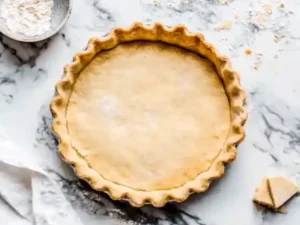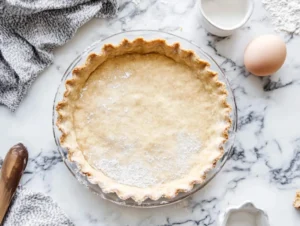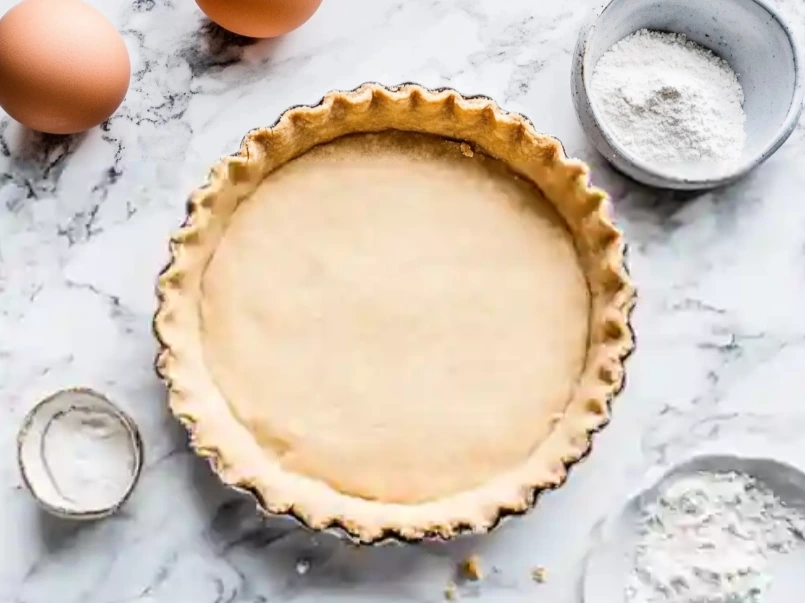Ultimate Guide to Making a Perfect Quiche Crust Recipe
What is a Quiche Crust?
A quiche crust is a foundational element of any quiche, acting as both a structural support and a complementary flavor to the rich, savory filling it encases. Typically made from shortcrust pastry, the quiche crust provides a buttery, flaky base that contrasts beautifully with the creamy, custard-like filling.
This essential component isn’t just about practicality—it’s also a canvas for creativity. From classic butter-based crusts to those enhanced with herbs, cheese, or alternative flours, the crust can elevate a quiche into a masterpiece. A well-made quiche crust ensures a perfect balance of texture and taste, preventing sogginess while delivering a melt-in-your-mouth experience.
History of Quiche and Its Crust
Origins of Quiche and Evolution Over Time
Quiche, as we know it today, originates from French cuisine but has roots tracing back to medieval Germany. The word “quiche” is derived from the German word “kuchen,” meaning cake. The earliest versions of quiche appeared in the region of Lorraine, hence the name “quiche Lorraine” for the iconic dish featuring bacon and cream.
Initially, the filling was the star of the show, and the crust served a primarily functional role, making the dish portable and preserving its integrity. Over centuries, the quiche evolved, incorporating diverse fillings and regional variations, from vegetables and seafood to spices and herbs. Alongside this evolution, the crust became more refined, with techniques to achieve the perfect texture and flavor becoming a culinary art form.
The Role of the Crust in Traditional French Cuisine
In traditional French cuisine, the quiche crust is much more than a vessel. It is a hallmark of skill, requiring precision in technique to achieve the ideal consistency—crispy, tender, and buttery. The French shortcrust pastry, known as pâte brisée, is the gold standard for quiche crusts. This delicate pastry not only supports the filling but also adds richness and depth to the dish.
The crust’s importance is underscored in French culinary schools, where aspiring chefs are rigorously trained in pastry-making. It symbolizes the essence of French cooking—where simplicity meets sophistication, and every component contributes to a harmonious whole.
Ingredients for a Classic Quiche Crust Recipe
Flour Types and Their Effects
Choosing the right type of flour is the first step to achieving a perfect quiche crust. Here’s a breakdown of common options and their impact:
- All-Purpose Flour: The most versatile and widely used option. It strikes a good balance between tenderness and sturdiness, making it ideal for beginners.
- Pastry Flour: Contains less protein than all-purpose flour, resulting in a more tender and flaky crust. This is a great choice if you want a delicate texture.
- Whole Wheat Flour: Adds a nutty flavor and hearty texture, though it can make the crust denser. Often mixed with all-purpose flour for balance.
- Gluten-Free Flour Blends: Designed for those avoiding gluten. They work well but often require added binding agents like xanthan gum for structure.
Fats: Butter vs. Shortening
The choice of fat profoundly influences the flavor and texture of your quiche crust:
- Butter: Provides unmatched flavor and contributes to a flaky texture when worked correctly. The water content in butter creates steam during baking, adding layers to the crust.
- Shortening: Produces a more tender and stable crust due to its higher melting point, but lacks the rich flavor of butter. It’s often combined with butter for the best of both worlds.
- Lard: A traditional fat that creates an exceptionally flaky crust with a subtle savory note, though it’s less commonly used today.
Optional Add-Ins for Flavor
Enhance your quiche crust with these flavorful additions:
- Herbs: Add finely chopped fresh or dried herbs like rosemary, thyme, or parsley for a savory twist.
- Spices: A pinch of ground black pepper, smoked paprika, or nutmeg can infuse subtle warmth and complexity.
- Cheese: Incorporate finely grated parmesan, cheddar, or gruyere into the dough for an extra layer of richness.
Equipment You’ll Need
Essential Tools for Making a Quiche Crust Recipe
To create a classic quiche crust, you’ll need a few indispensable tools:
- Mixing Bowl: For combining your ingredients efficiently.
- Pastry Cutter or Fork: To cut butter or shortening into the flour without warming it.
- Rolling Pin: Ensures an even thickness for your crust.
- Tart Pan or Pie Dish: A quiche requires a pan with high sides to hold the filling securely. A fluted tart pan with a removable bottom makes for easy serving.
- Parchment Paper and Pie Weights: These are essential for blind baking the crust to prevent puffing and ensure even baking.
Alternative Tools for Beginners
If you’re new to pastry-making or lack specialized tools, here are some substitutes:
- Food Processor: Speeds up the process of cutting fat into flour, ensuring a consistent texture.
- Wine Bottle: Works as a makeshift rolling pin in a pinch.
- Dried Beans or Rice: Can replace pie weights for blind baking. Simply layer them over parchment paper.
- Glass Pie Dish: Affordable and widely available, it works as a great alternative to a tart pan.

Step-by-Step Process to Make a Quiche Crust from Scratch
Mixing the Ingredients
- Combine Dry Ingredients: In a large mixing bowl, whisk together 1 ¼ cups of flour (all-purpose or your preferred type) and ½ teaspoon of salt. This ensures the salt is evenly distributed.
- Cut in the Fat: Add ½ cup of cold, unsalted butter (cut into small cubes) or shortening. Using a pastry cutter, fork, or your fingers, blend the fat into the flour until the mixture resembles coarse crumbs with pea-sized pieces.
- Add Water Gradually: Drizzle in 2–4 tablespoons of ice-cold water, one tablespoon at a time, mixing gently with a fork after each addition. Stop adding water when the dough just comes together without being sticky.
Rolling Out the Dough
- Chill the Dough: Shape the dough into a flat disk, wrap it in plastic wrap, and refrigerate for at least 30 minutes. This allows the gluten to relax and the butter to firm up.
- Prepare the Surface: Lightly flour a clean work surface and your rolling pin to prevent sticking.
- Roll the Dough: Roll the dough from the center outward, turning it occasionally to maintain an even thickness. Aim for a circle about 2 inches larger than your pan.
- Transfer to the Pan: Carefully lift the dough by rolling it onto your rolling pin or folding it into quarters, then gently lay it into your tart pan or pie dish. Press it lightly into the corners and trim any excess, leaving a small overhang to prevent shrinkage.
Pre-Baking the Crust (Blind Baking)
- Chill Again: Once the dough is in the pan, refrigerate it for another 20–30 minutes to prevent shrinking during baking.
- Prepare for Blind Baking: Preheat your oven to 375°F (190°C). Line the crust with parchment paper or aluminum foil and fill it with pie weights, dried beans, or rice to keep the crust flat.
- Bake the Crust: Bake for 15–20 minutes until the edges are lightly golden. Remove the weights and parchment paper, then bake for another 5–10 minutes to crisp the bottom. Allow it to cool before adding the filling.
Tips for Achieving a Flaky and Buttery Texture
The Role of Cold Ingredients
- Cold Butter or Fat: Keeping the butter or shortening cold prevents it from melting into the flour prematurely. When it melts during baking, it creates steam, which forms flaky layers.
- Ice Water: Ensures the dough stays cool and prevents the fat from softening during mixing.
Proper Dough Handling Techniques
- Work Quickly: Minimize the time the dough spends in your hands to avoid warming the fat.
- Avoid Overworking: Mix and knead the dough just enough to bring it together. Overworking can develop gluten, resulting in a tough crust.
- Chill at Every Stage: Chilling the dough after mixing, rolling, and shaping helps maintain its structure and ensures the crust holds its shape during baking.
Common Mistakes to Avoid
Overmixing the Dough
- Why It’s a Problem: Overmixing activates the gluten in the flour, leading to a dense, tough crust instead of the light, flaky texture you want.
- How to Avoid It: Mix the dough just until it comes together. It’s okay if it looks a bit shaggy before chilling—it will smooth out during rolling.
Under or Over-Baking Issues
- Under-Baking: A partially baked crust can lead to a soggy bottom, especially with liquid-rich quiche fillings.
- Solution: Always blind bake the crust until it’s golden and firm before adding the filling.
- Over-Baking: This can cause the crust to dry out and become overly hard.
- Solution: Keep an eye on the baking time and tent the edges with foil if they brown too quickly.
Cracking and Shrinkage Prevention
- Cracking: This often happens when the dough is too cold or has been rolled too thin.
- Solution: Let the dough sit at room temperature for a couple of minutes before rolling, and maintain an even thickness of about ⅛ inch.
- Shrinkage: This occurs when the dough isn’t rested properly or is stretched into the pan.
- Solution: Chill the dough after shaping, and gently press it into the pan without stretching.

Variations of Quiche Crusts
Gluten-Free Options
- Rice Flour Crust: Made with a mix of rice flour, tapioca flour, and potato starch, this crust mimics the texture of traditional pastry.
- Nut-Based Crusts: Almond flour and other nut flours create a rich, slightly crumbly crust that’s both gluten-free and flavorful.
- Gluten-Free All-Purpose Mixes: Convenient pre-made mixes are designed to replicate standard flour, making the process simpler.
Low-Carb Alternatives
- Almond Flour Crust: Combines almond flour with butter or eggs to form a tender, slightly nutty crust that’s perfect for keto-friendly diets.
- Cauliflower Crust: Blended cauliflower rice, cheese, and eggs create a sturdy, low-carb alternative that’s also gluten-free. It’s best for savory quiches with vegetable or cheese fillings.
- Coconut Flour Crust: A great low-carb option, though it requires more liquid due to its high absorbency.
Herb-Infused and Cheese Crusts
- Herb-Infused Crust: Mix chopped fresh or dried herbs like rosemary, thyme, or dill into the flour for an aromatic, savory twist.
- Cheese Crust: Incorporate grated cheese, such as parmesan or cheddar, directly into the dough. This adds richness and pairs beautifully with many quiche fillings.
- Spiced Crusts: Add spices like smoked paprika, cayenne pepper, or even garlic powder to the dough for a subtle flavor boost.
Quiche Crust Recipe FAQs
1. Is quiche crust the same as pie crust?
- Answer: While quiche crust and pie crust share similarities, such as being made from shortcrust pastry, they are used differently.
- Pie Crust: Typically sweeter and designed for desserts like fruit pies.
- Quiche Crust: Savory and less sweet, focusing on complementing the rich, custard-like filling. However, you can use a pie crust for quiche if needed, adjusting the sweetness accordingly.
2. Should I bake my crust first for quiche?
- Answer: Yes, pre-baking (or blind baking) the crust is essential for a good quiche. Blind baking ensures the crust doesn’t become soggy when the liquid filling is added.
- How To: Line the crust with parchment paper, fill with pie weights, and bake at 375°F (190°C) for 15–20 minutes. Remove the weights and bake for an additional 5–10 minutes until lightly golden.
3. Is heavy cream or milk better for quiche?
- Answer: It depends on the texture and richness you desire:
- Heavy Cream: Produces a richer, creamier filling due to its high fat content.
- Milk: Results in a lighter, less decadent filling.
- Best Option: A mix of both (e.g., half heavy cream, half whole milk) offers the perfect balance of creaminess and lightness.
4. What is the secret to a good quiche?
- Answer: Several factors contribute to a great quiche:
- Perfect Crust: Use cold ingredients and avoid overworking the dough to achieve a flaky, buttery crust.
- Balanced Filling: Ensure the filling is not too liquid-heavy by whisking eggs and cream in a ratio of about 1 egg to ½ cup of liquid.
- Layering Ingredients: Distribute cheese, vegetables, and meats evenly for balanced flavor in every bite.
- Avoid Overcooking: Bake the quiche until the center is just set but still jiggles slightly. It will continue to cook from residual heat after being removed from the oven.
5. Can I use store-bought crust for quiche?
- Answer: Absolutely! Store-bought crusts are a convenient option when you’re short on time. Just make sure to blind bake them as you would a homemade crust to prevent sogginess.
6. How do I prevent my quiche crust from shrinking?
- Answer: Shrinking often happens due to improper handling or insufficient chilling:
- Tips to Prevent Shrinkage:
- Allow the dough to rest in the refrigerator after rolling and shaping.
- Avoid stretching the dough to fit the pan, as it will contract during baking.
- Use pie weights during blind baking to help maintain the crust’s shape.
- Tips to Prevent Shrinkage:
- When discussing variations of quiche crusts, you could link to the article on gluten-free croissants to provide readers with ideas about gluten-free baking techniques.
- Under the section about low-carb alternatives, include a link to almond flour biscotti to further highlight the versatility of almond flour in different recipes.
- In the context of filling ideas for quiche, link to the article on sausage quiche recipe to showcase another quiche variation readers might enjoy.
- If your article mentions quick and easy crust options, refer readers to the Bisquick quiche recipe for a faster approach to quiche-making.
Conclusion: Perfecting the Quiche Crust Recipe
Mastering the art of a perfect quiche crust is a rewarding culinary endeavor that elevates any quiche from ordinary to extraordinary. By focusing on the fundamentals—using cold ingredients, avoiding overmixing, and properly blind baking—you can create a crust that is both flaky and buttery, providing the ideal foundation for any filling.
Key takeaways include the importance of choosing the right flour, understanding the role of fats, and exploring flavor-enhancing add-ins like herbs or cheese. Additionally, experimenting with variations such as gluten-free or low-carb crusts opens up possibilities to suit diverse tastes and dietary needs.

